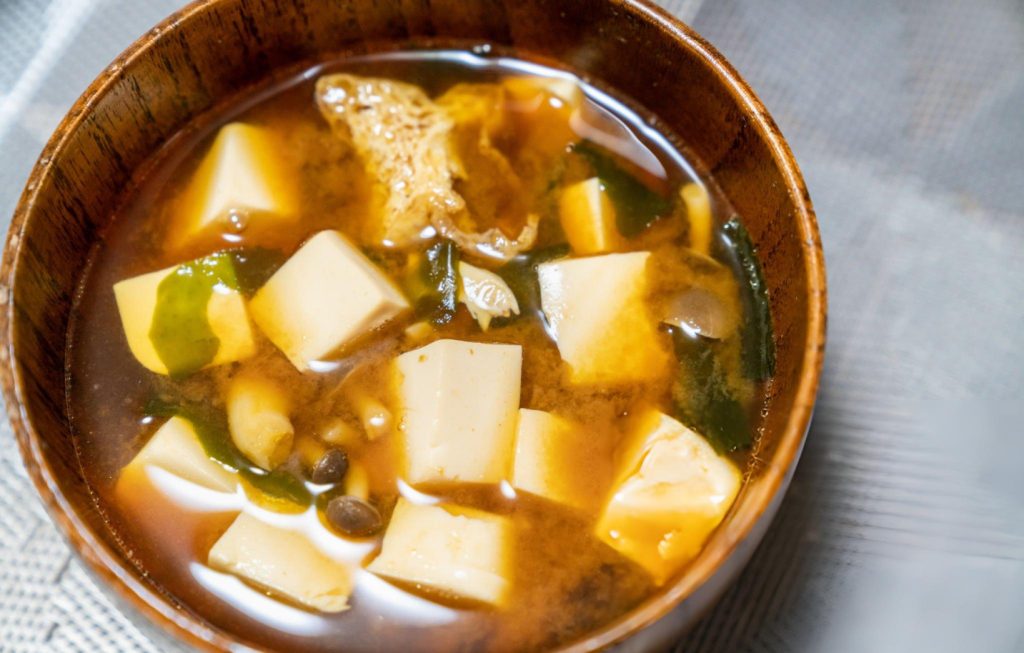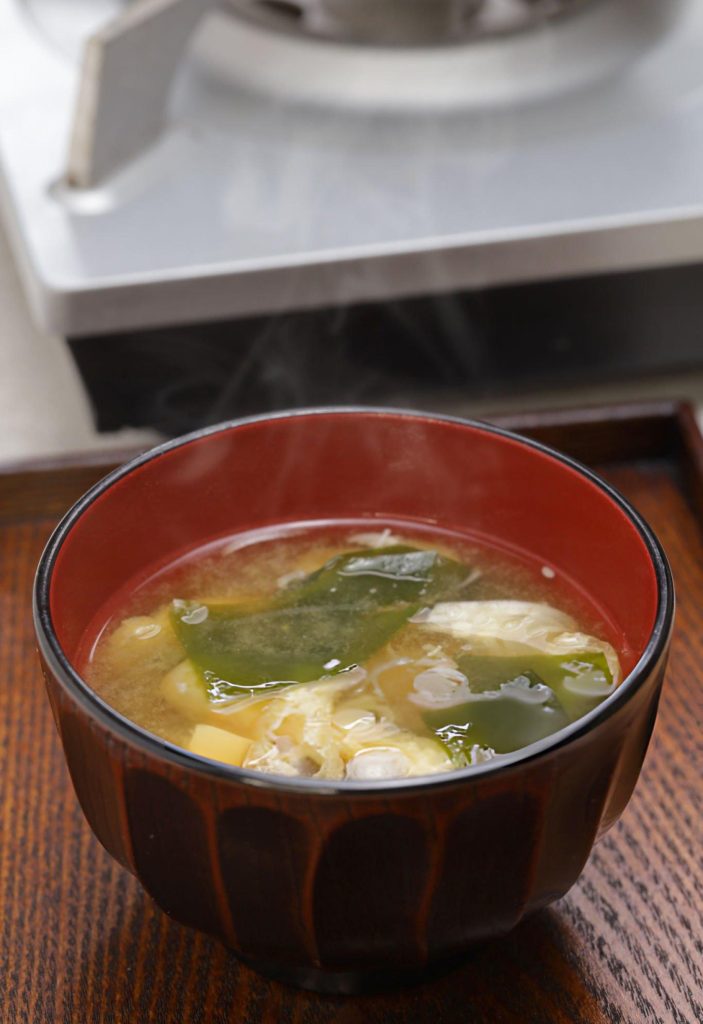Miso soup is a cornerstone of Japanese cuisine, offering a harmonious blend of savory umami flavors and comforting warmth. Its versatility allows it to shine as a light starter, a complementary side dish, or even a nourishing meal on its own. This recipe provides a step-by-step guide to crafting an authentic miso soup, capturing the essence of traditional preparation with modern tips for customization.

Ingredients Overview
The soul of this soup lies in its carefully chosen ingredients, each contributing to its depth of flavor and balance.
Dashi serves as the foundational broth, delivering a rich umami profile that sets the stage for the soup. Kombu (dried kelp) and katsuobushi (dried bonito flakes) create a delicate yet flavorful base. Miso paste, available in varying strengths and flavors, adds body and a savory-sweet complexity.
Soft silken tofu introduces a gentle creaminess and delicate texture, while dried wakame seaweed lends a subtle oceanic note. Finally, fresh green onions add a pop of color and a bright, sharp flavor, enhancing the overall presentation and taste. For those seeking to customize, mushrooms, daikon radish, or a sprinkle of sesame seeds can elevate the dish further.
Step-by-Step Preparation
Crafting miso soup begins with precision in each stage of preparation, ensuring that every element is perfectly balanced.
Making the dashi base starts with soaking kombu in water for at least 30 minutes. This step maximizes the extraction of umami compounds from the kelp. Slowly heat the water with the kombu, taking care to remove it just before the water boils to avoid bitterness. For a richer broth, add katsuobushi and simmer briefly before straining to create a clear, flavorful Awase Dashi.
Preparing the miso soup requires gentle heating of the dashi to maintain its nuanced flavors. Gradually dissolve miso paste into the broth using a ladle or fine-mesh strainer to achieve a smooth consistency without clumps. Once the miso is fully incorporated, gently add the tofu cubes, ensuring they remain intact.
Final touches, such as rehydrating wakame and sprinkling green onions, should be added just before serving. This preserves their vibrant color and fresh aroma, enhancing the visual and sensory appeal of the soup.

Recipe Tips
Perfecting the Dashi:
Opt for high-quality kombu and katsuobushi to achieve a clean, rich broth. Avoid boiling kombu to prevent unwanted bitterness.
Dissolving Miso Properly:
Always dissolve miso in a ladle or strainer to ensure it integrates seamlessly into the broth.
Maintaining Tofu’s Texture:
Add tofu after dissolving the miso to prevent breaking the delicate cubes during stirring.
What to Serve With This Recipe
Pairing miso soup with complementary dishes enhances its role in a meal.
For a complete Japanese-inspired menu, serve it alongside sushi rolls, crispy tempura, or a bowl of steamed rice. For lighter accompaniments, pickled vegetables or a simple salad with a tangy dressing provide a refreshing contrast to the soup’s savory profile.
Frequently Asked Questions
Can I Use Instant Dashi?
Yes, instant dashi can be a convenient alternative. Adjust the quantity to match the flavor intensity of traditional dashi.
What If I Don’t Have Miso Paste?
Substitutes like soybean paste or premade soup bases can work, though they may alter the flavor profile.
How Do I Prevent Over-salting?
Adjust the amount of miso added, or dilute the soup with additional dashi to balance the saltiness.
Storage and Reheating Suggestions
To maintain the freshness of miso soup, store it thoughtfully.
Refrigerate the soup without miso for up to 2 days and add the miso only when reheating the desired portion. Freezing is possible, but remove the tofu beforehand, as freezing alters its texture. When reheating, warm the soup gently over medium heat, avoiding boiling to preserve the delicate flavors and nutrients of the miso.
Presentation and Serving Suggestions
Tradition meets creativity in presenting miso soup.
For an authentic touch, place the soup on the right side of a Japanese table setting. Enhance its appearance with garnishes like sesame seeds, a drizzle of sesame oil, or vibrant microgreens. Layered bowls or ceramic dishes further elevate the presentation, making each serving feel special.
Making miso soup at home is both an art and a joy, blending simplicity with profound flavors. Whether paired with traditional dishes or enjoyed on its own, this recipe invites you to savor the essence of Japanese cuisine. Its adaptability to various tastes and dietary needs ensures it remains a favorite for all occasions.

Ingredients
For the Dashi (makes a scant 4 cups)
1 cup katsuobushi (dried bonito flakes), packed (or loosely packed 3 cups for stronger flavor)
4 cups water
1 piece kombu (dried kelp), ⅓ oz (10 g per piece; approximately 4 x 4 inches or 10 x 10 cm)
For the Miso Soup
4 Tbsp miso (1 Tbsp, 18 g for every 1 cup, 240 ml of dashi)
7 oz soft/silken tofu (kinugoshi dofu)
1 Tbsp dried wakame seaweed
1 green onion/scallion
Instructions
This recipe utilizes Awase Dashi, prepared with kombu and katsuobushi. For vegan or vegetarian options, kombu dashi or vegan dashi made with kombu and dried shiitake mushrooms can be used.
Add 4 cups of water and a piece of kombu to a medium-sized saucepan. If time permits, soak the kombu in water for 30 minutes to enhance the umami extraction. Never rinse kombu or remove the white powdery layer, as this is a natural source of umami. Ensure the kombu is free from visible dirt particles.
Heat the water slowly over medium-low heat, taking about 10 minutes to bring it to a near boil. This gradual process maximizes umami extraction. Remove the kombu just before the water begins to boil to avoid a slimy texture or bitterness.
For non-vegan/vegetarian preparation, add 1 cup of katsuobushi to the kombu-infused dashi. Bring the mixture back to a boil, then reduce the heat and let it simmer for 30 seconds. Turn off the heat and allow the bonito flakes to sink to the bottom for about 10 minutes. Strain the liquid through a fine-mesh sieve, reserving the spent katsuobushi for another use.
Store the dashi in the refrigerator for up to 5 days or freeze for up to 2 weeks. This recipe yields approximately 4 cups of Awase Dashi.
Pour the prepared dashi into a saucepan. If using refrigerated dashi, heat it gently to a simmer (205°F/96°C) over medium heat, then turn off the heat.
Measure 4 tablespoons of miso and place it into a ladle. Gradually ladle in the hot dashi while stirring the miso with chopsticks until it dissolves completely. Avoid adding miso directly into the soup without dissolving it first, as this ensures a smooth consistency.
Cut the soft tofu into ½-inch cubes and gently add them to the soup after the miso is fully dissolved. This prevents the tofu from breaking during stirring.
Add 1 tablespoon of dried wakame and the thinly sliced green onion just before serving to retain their fresh color and fragrance. If desired, rehydrate the wakame separately in water to remove excess salt before adding it to the soup.
Serve the miso soup immediately, ensuring it is warm but not boiling. Boiling can diminish the soup’s delicate flavors and aromas. For a traditional touch, place the soup on the right side of the table setting.
While best enjoyed fresh, miso soup can be stored if necessary. Allow the soup to cool to room temperature before refrigerating. Consume within 2 days. For longer storage, freeze the soup without the miso and add it only when reheating a portion. Avoid freezing tofu, as its texture changes upon thawing.
Reheat the miso soup in a pot over medium heat, ensuring it does not boil. High temperatures can degrade the flavor, aroma, and nutrients of the miso. Stir occasionally to heat evenly before serving.

Miso Soup Recipe
Ingredients
For the Dashi (makes a scant 4 cups)
- 1 cup katsuobushi dried bonito flakes, packed (or loosely packed 3 cups for stronger flavor)
- 4 cups water
- 1 piece kombu dried kelp, ⅓ oz (10 g per piece; approximately 4 x 4 inches or 10 x 10 cm)
For the Miso Soup
- 4 Tbsp miso 1 Tbsp, 18 g for every 1 cup, 240 ml of dashi
- 7 oz soft/silken tofu kinugoshi dofu
- 1 Tbsp dried wakame seaweed
- 1 green onion/scallion
Instructions
- This recipe utilizes Awase Dashi, prepared with kombu and katsuobushi. For vegan or vegetarian options, kombu dashi or vegan dashi made with kombu and dried shiitake mushrooms can be used.
- Add 4 cups of water and a piece of kombu to a medium-sized saucepan. If time permits, soak the kombu in water for 30 minutes to enhance the umami extraction. Never rinse kombu or remove the white powdery layer, as this is a natural source of umami. Ensure the kombu is free from visible dirt particles.
- Heat the water slowly over medium-low heat, taking about 10 minutes to bring it to a near boil. This gradual process maximizes umami extraction. Remove the kombu just before the water begins to boil to avoid a slimy texture or bitterness.
- For non-vegan/vegetarian preparation, add 1 cup of katsuobushi to the kombu-infused dashi. Bring the mixture back to a boil, then reduce the heat and let it simmer for 30 seconds. Turn off the heat and allow the bonito flakes to sink to the bottom for about 10 minutes. Strain the liquid through a fine-mesh sieve, reserving the spent katsuobushi for another use.
- Store the dashi in the refrigerator for up to 5 days or freeze for up to 2 weeks. This recipe yields approximately 4 cups of Awase Dashi.
- Pour the prepared dashi into a saucepan. If using refrigerated dashi, heat it gently to a simmer (205°F/96°C) over medium heat, then turn off the heat.
- Measure 4 tablespoons of miso and place it into a ladle. Gradually ladle in the hot dashi while stirring the miso with chopsticks until it dissolves completely. Avoid adding miso directly into the soup without dissolving it first, as this ensures a smooth consistency.
- Cut the soft tofu into ½-inch cubes and gently add them to the soup after the miso is fully dissolved. This prevents the tofu from breaking during stirring.
- Add 1 tablespoon of dried wakame and the thinly sliced green onion just before serving to retain their fresh color and fragrance. If desired, rehydrate the wakame separately in water to remove excess salt before adding it to the soup.
- Serve the miso soup immediately, ensuring it is warm but not boiling. Boiling can diminish the soup’s delicate flavors and aromas. For a traditional touch, place the soup on the right side of the table setting.
- While best enjoyed fresh, miso soup can be stored if necessary. Allow the soup to cool to room temperature before refrigerating. Consume within 2 days. For longer storage, freeze the soup without the miso and add it only when reheating a portion. Avoid freezing tofu, as its texture changes upon thawing.
- Reheat the miso soup in a pot over medium heat, ensuring it does not boil. High temperatures can degrade the flavor, aroma, and nutrients of the miso. Stir occasionally to heat evenly before serving.



